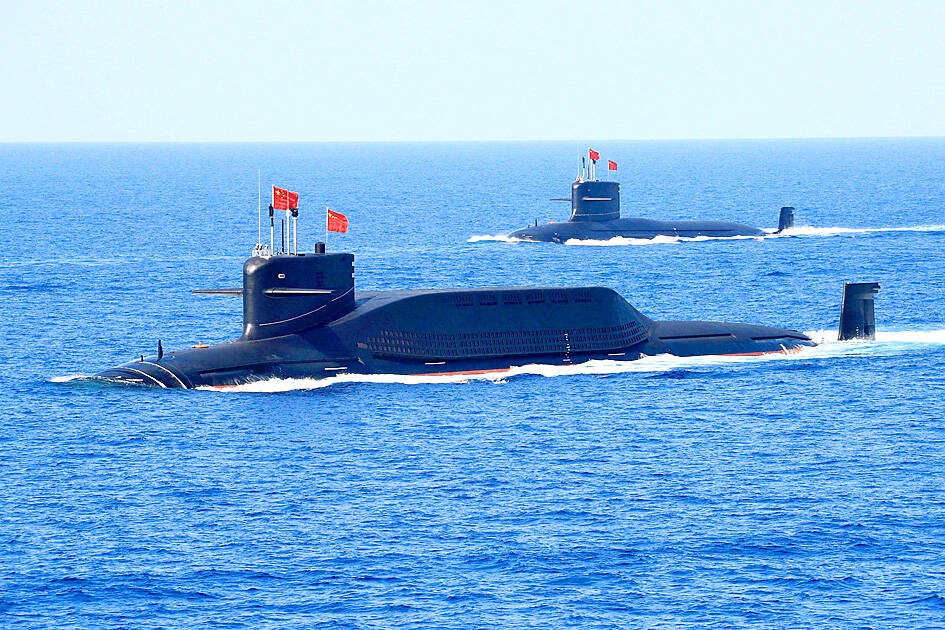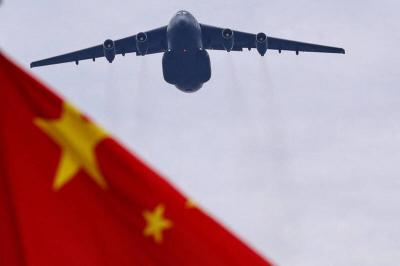China has about 70 conventional submarines on active duty as well as two new nuclear submarines that no longer carry a “turtle-back” design, an annual report published by the Institute for National Defense and Security Research said.
The capabilities of the two new nuclear submarines — the Type 095 and Type 096 — match those used by the US and Russia, the institute’s 2023 Assessment Report of the Chinese Communist Partys’ (CCP) Government and Military Development said.
The analysis of China’s People’s Liberation Army Navy (PLAN) combat capabilities conducted by retired Republic of China Navy captain Chiang Shin-biao (江炘杓) offered a different assessment from the US Department of Defense’s report on Military and Security Developments Involving the People’s Republic of China, published last year. The US report said that China has about 60 submarines, including six ballistic missile nuclear submarines, six nuclear-powered attack submarines and 48 submarines powered by diesel or air-independent propulsion (AIP), also known as hunter-killer submarines.

Photo: Reuters
However, it warned, that China would have 65 submarines in its fleet by next year, and the number could increase to 80 by 2035.
Chiang said the US report gave a relatively conservative estimate based on the existing intelligence.
“However, the Nuclear Threat initiative, a US non-profit organization, had said its data collected in 2020 showed that China had 65 to 70 submarines. Supposing that China can build two submarines per year and retire some annually, it should have about 70 submarines in its fleet. The number could reach 76 by 2030,” he said.
China’s navy uses mainly diesel-powered or AIP-powered submarines for offshore defense, such as the Type 039C submarine, which has a full load displacement of about 3,600 tonnes, a diving depth of more than 300m and a maximum submersible speed of about 22 knots (40.74kph), Chiang said.
The submarine can carry 12 torpedoes and six submarine-launched missiles, he said, adding that it could be mass-produced as it is a well-developed technology and has better silent effects and stronger strike effectiveness.
The PLAN now has one Type 095 nuclear-powered attack submarine on active duty, Chiang said. The nuclear submarine’s maximum diving depth is 500m and has a self-sustaining capability of about 90 days, he said.
It can carry 24 torpedoes and 16 vertical launch units and is equipped with YJ-18 anti-ship missiles, CJ-10 land attack cruise missiles and HQ-10 anti-aircraft missiles, he added.
Aside from having one Type 092 and six Type 094 ballistic missile nuclear submarines, the PLAN is building a Type O96 submarine, Chiang said.
The displacement of the third-generation submarine is expected to be enlarged to 15,000 tonnes, and is equipped with 24 JL-3 ballistic missiles and YJ-18 series anti-ship missiles, he said. “The new nuclear submarine not only can carry out nuclear counter attacks against the enemy, but also attack the enemy’s fleet on the sea surface from a long distance. It has a deterrent effect on an enemy’s carrier strike group and establishes favorable conditions for ‘anti-access/area denial’ military strategies,” Chiang said, adding that a sizable fleet using Type 096 submarines might be formed by 2030.
While the US Navy has said the Chinese Navy’s expanding submarine fleet has yet to pose a challenge, Chiang said the Type 094 and other models of previous ballistic missile nuclear submarines had the problem of an overly large “turtle back” configuration for submarine-launched missiles. “However, as China’s submarine-launched missile miniaturization technology improves, these two new nuclear submarines will completely rid Chinese nuclear submarines of being nicknamed ‘undersea tractors,’ and their performance will also be improved, keeping pace with the US and Russia,” he said.
Taiwan’s Admiral Huang Shu-kuang (黃曙光), who heads Taiwan’s indigenous defense submarine program, said he hopes the nation has three combat-ready submarines by next year and four by 2027.

Beijing could eventually see a full amphibious invasion of Taiwan as the only "prudent" way to bring about unification, the US Department of Defense said in a newly released annual report to Congress. The Pentagon's "Annual Report to Congress: Military and Security Developments Involving the People's Republic of China 2025," was in many ways similar to last year’s report but reorganized the analysis of the options China has to take over Taiwan. Generally, according to the report, Chinese leaders view the People's Liberation Army's (PLA) capabilities for a Taiwan campaign as improving, but they remain uncertain about its readiness to successfully seize

Taiwan is getting a day off on Christmas for the first time in 25 years. The change comes after opposition parties passed a law earlier this year to add or restore five public holidays, including Constitution Day, which falls on today, Dec. 25. The day marks the 1947 adoption of the constitution of the Republic of China, as the government in Taipei is formally known. Back then the Chinese Nationalist Party (KMT) governed China from Nanjing. When the KMT, now an opposition party in Taiwan, passed the legislation on holidays, it said that they would help “commemorate the history of national development.” That

Trips for more than 100,000 international and domestic air travelers could be disrupted as China launches a military exercise around Taiwan today, Taiwan’s Civil Aviation Administration (CAA) said yesterday. The exercise could affect nearly 900 flights scheduled to enter the Taipei Flight Information Region (FIR) during the exercise window, it added. A notice issued by the Chinese Civil Aviation Administration showed there would be seven temporary zones around the Taiwan Strait which would be used for live-fire exercises, lasting from 8am to 6pm today. All aircraft are prohibited from entering during exercise, it says. Taipei FIR has 14 international air routes and

The Ministry of National Defense (MND) today released images of the military tracking China’s People's Liberation Army (PLA) movements during the latest round of Chinese drills around Taiwan. The PLA began "Justice Mission 2025" drills today, carrying out live-fire drills, simulated strikes on land and maritime targets, and exercises to blockade the nation's main ports. The exercises are to continue tomorrow, with the PLA announcing sea and air space restrictions for five zones around Taiwan for 10 hours starting from 8:30am. The ministry today released images showing a Chinese J-16 fighter jet tracked by a F-16V Block 20 jet and the